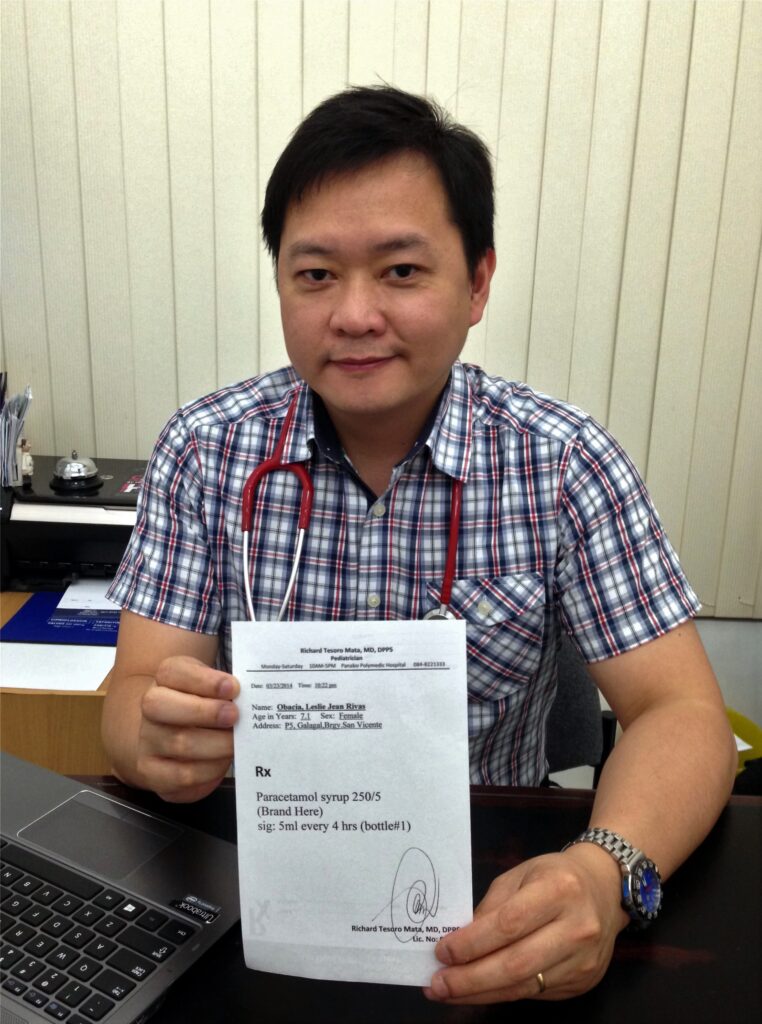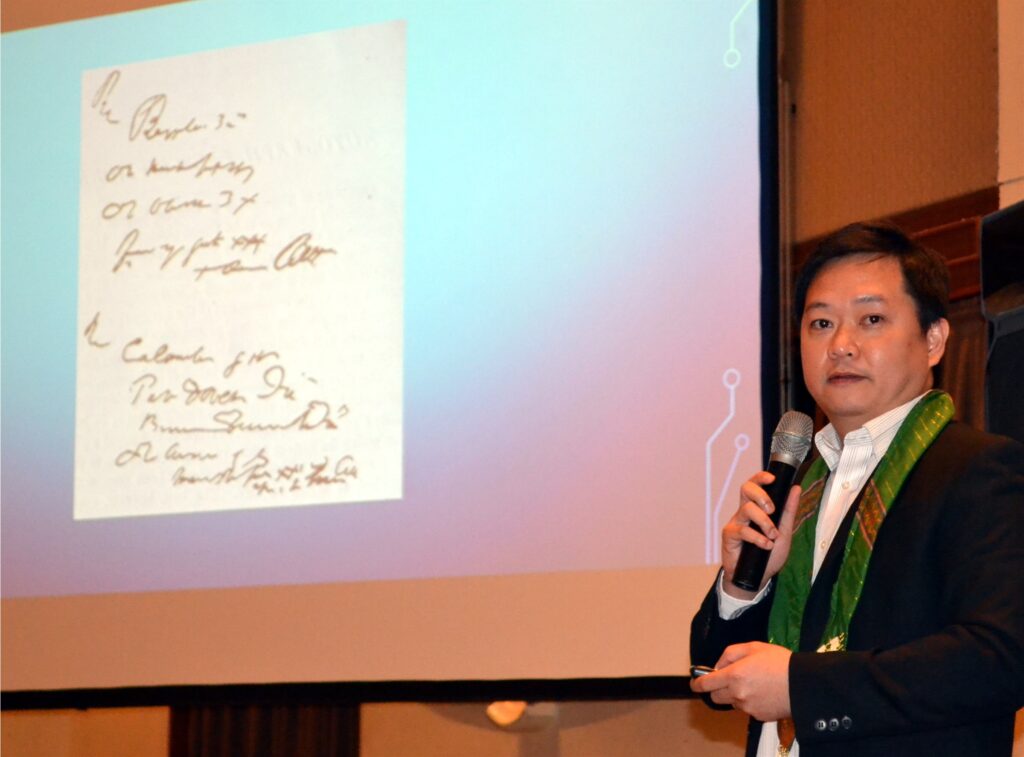SAYING GOODBYE TO HANDWRITTEN PRESCRIPTIONS
Text and Photos by Henrylito D. Tacio
Three days after being confined in a small town’s private hospital, seven-year-old Jonathan was given a go signal by his doctor to go home. The attending physician wrote something in Rx paper and handed it to the mother. “You need to buy these medicines since we don’t have them at the hospital.”
The mother brought her son to their house and returned to the public market to buy the medicines which the doctor told her. She gave the handwritten prescription to the pharmacist.
At first, the pharmacist had a hard time deciphering what the doctor had written. But later on, she gave the mother the medicines and told her how many times each day the medicines will be given.
The mother went home and gave the medicines as told. Two days later, Jonathan was getting worse instead of getting better. Then, on the third night, Jonathan’s body temperature went up; he was chilling.
The parents immediately brought Jonathan back to the hospital. It was good that the doctor assigned that night was the same physician who transcribed the handwritten prescription. “What happened,” he asked.
The mother told him the story. “Let me see the medicine you are giving to your son,” the doctor asked. After seeing the medicine, the doctor said, “This is not the medicine I was prescribing to your son.”
The mother went back to the drug store. It was then that she found that the pharmacist who gave her the medicines had misread the handwritten prescription. “I can’t read what the doctor had written,” she admitted.
In November 1999, medication errors became front-page news in the United States with a compelling report from the Institute of Medicine. One newspaper carried this opening statement: “Two people in the United States just died in the last hour. Seventeen more will die in the next 7 to 8 hours. Over a year, that number will accumulate to about 7,000.”
Cited for those deaths are medical errors that include misread or otherwise misinterpreted handwritten prescriptions. Does this mean that doctors are sloppy and pharmacies are making mistakes?
Today’s doctors can now say goodbye to those unreadable handwritten prescriptions. They can do so by using a web-based application developed by a physician himself from Davao City.

The software doesn’t convert writing into computer text but provides an efficient system for directly putting medical information into a computer database.
“The software program can computerize the admitting orders,” explained Dr. Richard T. Mata, a pediatrician and a Diplomat of the Philippine Pediatrician Society. “It can also digitalize the patient’s records in the clinic. All the information can be saved on the desktop, laptop, or even saved to an iPhone, IPad, or Android.”
Once the information is saved, the doctor can have it anytime, anywhere at the tip of his finger. The days of those old-fashioned patient cards and space-occupying cabinets (where the cards are kept) are numbered.
“The United States has already been shifting to e-prescribing for about a decade now,” Dr. Mata pointed out in his presentation during the recent Regional Forum on eHealth in Davao City. “Handwritten prescriptions are being discouraged because of the findings on the danger of handwritten Rx.”
Dr. Mata said he developed the software — Computerization of Prescriptions and Patient Records — as the country’s counterpart of e-prescription. “Well, to strictly define e-prescription, it actually means that the doctor sends the digital Rx via the internet to the pharmacists as done in the United States. But in my case, I only print the Rx in my clinic and give it to the patient as the country is not yet ready to do e-prescription.”
He further explained: “In the software, I developed, speed and being user-friendly are the two top priorities,” he said. “I can guarantee that it is faster than writing since the doctor can just choose the prepared database of prescriptions as fast as he can look for a name in his mobile phone book.”
Dr. Mata cited several advantages of e-prescription over handwritten ones. “The clearer the prescriptions, the safer for the patients,” he said. It is also safer for the doctors for the possibility of being sued, he added.
“One major advantage of the program is that it automatically saves the prescription details under the patient’s name in the database,” he explained. “Unlike in handwritten prescriptions, what the doctor has written in the paper is not duplicated word per word and can be saved as a file for future reference.”
Aside from the prescribed medicines, the doctor can also include other information like history, chief complaints, diagnosis, and laboratory results, among others.
“To make it even more powerful, the doctor can even synchronize the patient’s data from the personal computer to iPhone, IPad, or Android so he can review needed information anywhere,” he said.
Dr. Mata finished his medical degree at the Davao Medical School Foundation in 1997. He had his Pediatric residency training at San Pedro Hospital of Davao. “Inspiration and desperation,” he said on why he became a doctor. On inspiration, he explained: “Dr. Honorio de la Cruz was my pediatrician when I was still a kid. When my parents and I went to the clinic, there were always hundreds of others waiting for their turn. My father and mother always told me, “Be a pediatrician, and you will have this number of patients!”
In desperation, he said he saw how his parents’ business went down. “I literally saw people taking away our piano, our television, our sala set, and eventually our house due to business debts,” he recalled. “I told myself: ‘I need to be a doctor!’ Paying the tuition fees, of course, is another story, but thank God we made it through.”
According to him, his main intention of making a medical computer program was for his personal clinic use only. He wanted to provide clearer and readable Rx to his patients and simultaneously digitalized his patient records for easier retrieval and to maximize clinic space as well as mobility.
“In 2004, my practice as a pediatrician was booming in Panabo City, but I need something to make my work faster to accommodate the patients without me getting too exhausted,” he admitted. “So I searched the web for any downloadable software for computerized prescriptions.”
During his search, Dr. Mata realized that the United States was already campaigning to eradicate the unreadable handwritten Rx. He found out that some computer programs were already available, but unfortunately, they were all designed for American use. “I also noticed that the programs will take lots of clicks to make an output. So it dawned on me that there must be a software that is customized for Filipino doctors which will require lesser clicks to make things faster.”
So, he searched and tried other medical software programs on the web, but in the end, he felt that his needs were not fully met by what was available. So he opted to do it himself with some professional help. He acquired his computer programming skill when the palm pilot became very popular. This was in 1999.

“My pre-med was biology, so basically, I don’t know about programming,” Dr. Mata said. “But there’s one thing I am proud of myself. When I was in Grade 3 in Ateneo De Davao, I was the only one who was able to decipher in finishing the Rubik’s cube in all colors by doing ‘trial and error’ for about 2 weeks. I was a popular kid on campus for that reason. So I know I have a talent. So I decided to read websites on software programming and website development for newbies.”
A popular software at that time was the award-winning HanDBase by DDH Software. The best thing about it was its “customizable database program” (that runs on Desktop and Mobile Devices). As such, it became a favorite among medical practitioners.
Through long hours of studying the manuals and tutorial videos for several years and communication with David Haupert (the founder of DDH Software himself), Dr. Mata was able to design medical programs which he used in his practice.
After three years of improving the program (through the daily application, trial, and error and upgrading), Dr. Mata passed it for an international software contest and was chosen the winner of Applet of the Year 2008 by DDH Software.
Aside from doctors and patients, the program Dr. Mata developed also benefits the nurses and pharmacists.
On pharmacists, Dr. Mata said: “Their job will become easier as they won’t have a hard time deciphering a doctor’s handwriting. They will also be safe from the consequences of giving the wrong medicines to patients.”
Nurses don’t seem to complain, but like pharmacists, they also have some difficulties in understanding the handwritten prescriptions that come their way at the emergency room. “High clarity is a must, especially for patients to be admitted because everything relies on what’s being written. The nurses just administer what is being written,” Dr. Mata said.
There are only things a doctor needs to make computerized prescription work. Aside from being computer literate, a doctor should do the following: (1) Purchase a personal computer to be placed in his clinic; (2) Connect a compatible printer to the PC, and (3) Use the free software downloadable at www.easyclinicsoftware.com.
“Our first intention was to reach the Filipino doctors only,” he admitted, “but instead, it became popular to other countries as well.”
For the past eight months, around 14,748 doctors worldwide visited the website, with India on top at 5,438 visitors, followed by the United States (1,474) and the Philippines (1,205).
But Dr. Mata has a dream. He wants to see the Philippines in the future be the first country in the world to issue prescriptions that are computerized.
By the way, on why doctors have such sloppy writing, Dr. Mata offers this explanation: “During training, we write all the time, and we are almost always in a hurry. So we write more than 100 prescriptions a day for the patients to be discharged and those from outpatient clinics. Suddenly, sudden emergency calls are anytime, and also, we need to accompany our 5-10 mentors per day during rounds, so we need to finish things faster. Although honestly, my writing was already bad prior to the above, so what do you expect?”

